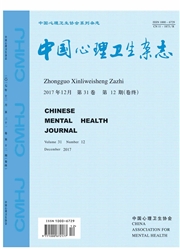

 中文摘要:
中文摘要:
目的:探讨述情障碍者的情绪认知加工特征,并分析述情障碍者的认知性情绪调节特征。方法:在本对照研究中,采用班级整群抽样的方法抽出712名学生。采用多伦多述情障碍20个条目量表(TAS-20)中文版筛选出述情障碍者(TAS-20≥58分)117名和非述情障碍者(TAS-20≤38分)118名,比较两组认知情绪调节问卷(CERQ)、抑郁自评量表(CES-D)得分差异。间隔2~3个月后利用TAS-20对这235名受试进行重测,筛选出51名述情障碍者与54名非述情障碍者,分别对120张情绪图片进行愉悦度、唤醒度和优势度评分。结果:(1)述情障碍组消极应对维度得分高于非述情障碍组[(47.3±5.9)VS.(41.9±5.9),P〈0.001],而积极应对维度得分低于非述情障碍组[(65.2±7.7)VS.(71.1±7.3),P〈0.001]。(2)在愉悦度的评分上,述情障碍组对正性图片的评分低于非述情障碍组[(7.0±1.0)vs.(7.7±1.0),P〈0.001],而对负性图片的评分高于非述情障碍组[(2.4±1.0)vs.(1.4±1.0),P〈0.001];唤醒度方面,述情障碍组对正性和负性图片的评分均低于非述情障碍组[正性:(6.3±1.2)vs.(6.8±1.1),P=0.040;负性:(6.4±1.5)vs.(7.2±1.4),P=0.007]。结论:述情障碍者存在情绪的认知加工缺陷,且存在认知性情绪调节缺陷。
 英文摘要:
英文摘要:
Objective: To explore the characteristics of emotion cognitive processing and cognitive regulation in alexithymia. Methods: A total of 117 alexithymic subjects ( TAS-20 scores ≥58 ) and 118 nonalexithymie subjects (TAS-20 scores ≤38 ) were selected with the Chinese version of 20-item Toronto Alexithymia Scale (TAS-20 ), and their scores on the Center for Epidemiologic Studies Depression Scale ( CES-D ) and Cognitive Emotion Regulation Questionnaire CERQ were compared. Then 51 alexithymie subjects and 54 nonalexithymie subjects were required to rate 120 affective pictures to three dimensions ( valence, arousal and dominant) . Results: ( 1 ) Compared with nonalexi- thymic group, alexithymic group got higher scores in negative coping dimension [ (47. 3 ±5.9) vs. (41.9 ±5. 9) , P 〈 0. 001 ], while got lower scores in positive coping [ ( 65. 2 ± 7.7 ) vs. ( 71.1 ± 7. 3 ), P 〈 0. 001 ] . ( 2 ) In va- lence rating, alexithymie group gave lower score for positive pictures [ ( 7.0 ± 1.0 ) vs. ( 7.7 ± 1.0 ), P 〈 0. 001 ] and higher score for negative pictures [ [2. 4 ± 1. 0) vs. [ 1.4 ± 1.0) , P 〈0. 001 ] than nonalexithymic group. In arousal dimension, alexithymic group gave lower scores to both positive pictures and negative pictures than nonalexithymic group [ (6.3±1.2) vs. (6.8±1.1), (6.4±1.5) vs. (7.2±1.4); P〈0.01] .Conclusion: Alexithymia subjects have deficits in emotion cognitive processing and emotion cognitive regulation.
 同期刊论文项目
同期刊论文项目
 同项目期刊论文
同项目期刊论文
 期刊信息
期刊信息
